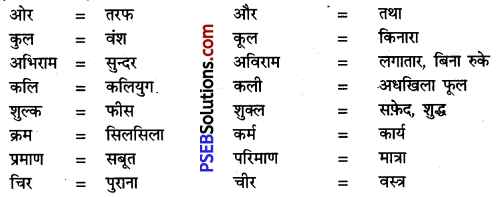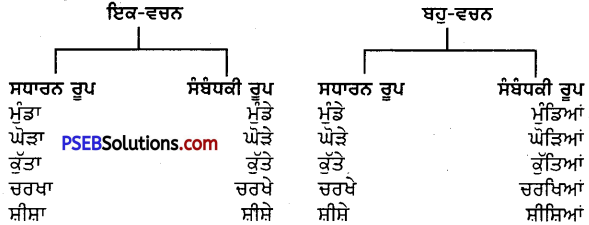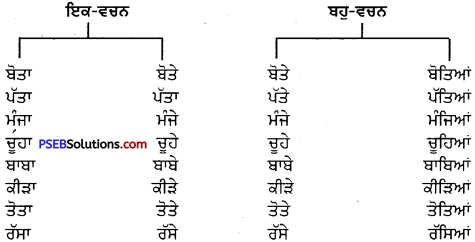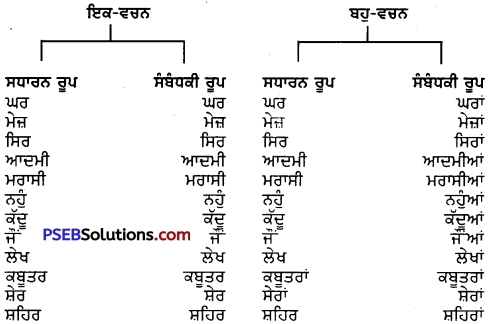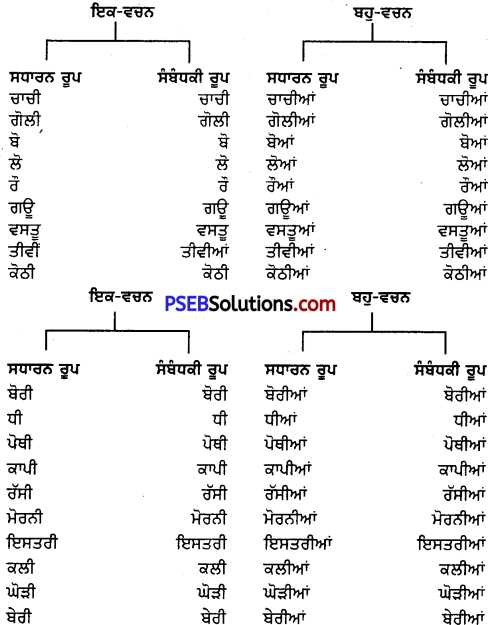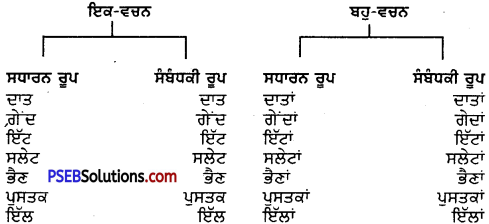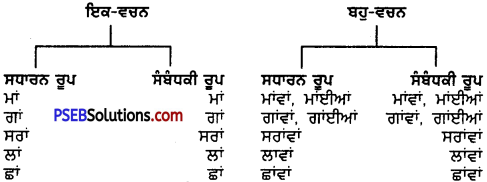Punjab State Board PSEB 8th Class Hindi Book Solutions Chapter 8 बस चुप भली Textbook Exercise Questions and Answers.
PSEB Solutions for Class 8 Hindi Chapter 8 बस चुप भली
Hindi Guide for Class 8 PSEB बस चुप भली Textbook Questions and Answers
(क) भाषा – बोध
I. शब्दार्थ
निगाह = नज़र।
जुबानदराजी = अधिक बोलने की आदत।
दस्तक = खटखटाना।
जहर उगलना = बुरा-भला कहना।
रामबाण औषधि = अचूक दवा।
नसीहतें = उपदेश।
बयान = वर्णन करना।
चटोरी = स्वाद लेने वाली।
रसना = जीभ।
![]()
II. इन मुहावरों को अपने वाक्यों में प्रयोग करें:
1. काला अक्षर भैंस बराबर
2. छाती पर मूंग दलना
3. फाँसी का फंदा चूमना
4. कान पकड़ना
5.मैदान में कूद पड़ना
6. राग अलापना
7. नमक खाना
8. अपना-सा मुँह लेकर चले जाना
9. जान के पीछे पड़ना
उत्तर:
1. काला अक्षर भैंस बराबर – आज के युग में काला अक्षर भैंस बराबर व्यक्ति को समाज में सम्मान प्राप्त नहीं होता।
2. छाती पर मूंग दलना – गणेशी का बदमाश पोता न पढ़ता है और न ही कोई काम करता है, बस बूढ़ी दादी की छाती पर मूंग दलता रहता है।
3. फाँसी का फंदा चूमना – भगत सिंह ने देश के लिए खुशी-खुशी फाँसी का फंदा चूम लिया था।
4. कान पकड़ना – मैं तो कान पकड़ता हूँ कि तुम्हारे घर अब कभी नहीं आऊँगा।
5. मैदान में कूद पड़ना – झांसी की रानी अंग्रेजों के व्यवहार से क्रोधित हो कर मैदान में कूद पड़ी थी।
6. राग अलापना – तेरी यहाँ कोई सुनवाई नहीं तो फिर क्यों अपना राग अलाप रहा है।
7. नमक खाना – तुम्हारा बरसों तक नमक खाया है इसलिए यह काम तो मुझे करना ही पड़ेगा।
8. अपना-सा मुँह लेकर चले जाना – अफ़सर ने जब गाँव वालों की बात सुनी ही नहीं तो वे अपना-सा मुँह लेकर चले गए।
9. जान के पीछे पड़ना – ये गुंडे तो तुम्हारी जान के पीछे पड़े हुए हैं इसलिए जल्दी पुलिस की सहायता प्राप्त करो।
(ख) विषय – बोध
I. सही पर (✓) और गलत पर (×) का चिह्न लगायें :
(क) जुबानदराजी बुरी आदत है?
(ख) मौन के बल पर कालिदास का विवाह राजकुमारी से नहीं हुआ था। ( )
(ग) निर्दय जुबान के कारण रहीम अन्तिम दिनों में परेशान हुए थे। ( )
(घ) बिहारी लाल और मुरारी लाल को साहब ने तरक्की दी थी। ( )
(ङ) चुनाव अभियान में लेखक ने खन्ना का पक्ष लिया था। ( )
उत्तर:
सही- क, ग।
गलत- ख, घ, ङ।
![]()
II. इन प्रश्नों के उत्तर एक या दो वाक्यों में लिखें :
प्रश्न (क)
सब आफ़तों से बचने की रामबाण औषधि क्या है?
उत्तर:
सब आफ़तों से बचने की रामबाण औषधि मौन धारण कर लेना है।
प्रश्न (ख)
न चाहते हुए भी हम क्यों जुबानदराजी करते हैं?
उत्तर:
न चाहते हुए भी मन के भावों के कारण जुबान नियंत्रण में नहीं रहती है और हम जुबानदराजी करते हैं।
प्रश्न (ग)
जुबानदराजी के कारण मनसूर का क्या परिणाम हुआ?
उत्तर:
जुबानदराजी के कारण मनसूर को फांसी के फंदे पर झूलना पड़ा था।
प्रश्न (घ)
अपने ही घर में लेखक को मेहमान क्यों बनना पड़ा?
उत्तर:
लेखक को अपने किसी जान-पहचान वाले के बेटे की शादी में न चाहते हुए भी भागीदार बनने के कारण अपने ही घर में मेहमान बनना पड़ा था।
प्रश्न (ङ)
बिहारी लाल और मुरारी लाल की गवाही से लेखक ने मुक्ति किस युक्ति से ली?
उत्तर:
लेखक को झूठ-मूठ की भयंकर खाँसी का बहाना करने की युक्ति से बिहारी लाल और मुरारी लाल की गवाही से मुक्ति मिली थी।
III. चार या पाँच वाक्यों में उत्तर लिखें:
प्रश्न (क)
एक चुप सौ सुख’ इस तथ्य (सच्चाई) को अपनी युक्तियों से स्पष्ट करें।
उत्तर:
वास्तव में ही ‘एक चुप सौ सुख’ एक सच्चाई है। यदि दो मित्र आपस में किसी भी बात पर झगड़ पड़ें तो उन में से किसी एक का पक्ष नहीं लिया जा सकता। ऐसा करने से उन दो में से एक मित्र का दुश्मन बन जाना निश्चित होता है। लड़ाई-झगड़ा तो घर में भी हो जाता है। चुप रह कर किसी भी पक्ष का साथ न देना समस्या को कम ही करता है और अपने शत्रुओं और विरोधियों की संख्या को भी कम करता है।
![]()
प्रश्न (ख)
क्या हर स्थिति में चुप रहना चाहिए’ अपने विचार लिखें।
उत्तर:
हर स्थिति में चुप नहीं रहना चाहिए। ऐसा तो केवल वही कर सकता है जो मूर्ख हो या पागल हो। जब कोई अन्याय के रास्ते पर चलता हुआ किसी पर भी अनावश्यक रूप से अत्याचार कर रहा हो तो चुप नहीं रहना चाहिए। देखकर मक्खी नहीं निगली जा सकती। जब हमारे हितों को चोट लग रही हो या किसी पर भी अनर्थ ढाया जा रहा हो तो चुप नहीं रहना चाहिए, सदा चुप रहने वाले को लोग मूर्ख ही मानते हैं और जीवन जीते हुए मूर्ख कदापि नहीं बनना चाहिए। इसके लिए व्यवहार बुद्धि का प्रयोग करना चाहिए।
प्रश्न (ग)
बिहारी लाल और मुरारी लाल के झगड़े से बचने के लिए लेखक ने क्या नाटक किया?
उत्तर:
बिहारी लाल और मुरारी लाल के झगड़े से बचने के लिए लेखक ने अपने दफ़्तर के साहब से भयंकर खांसी का नाटक किया था। वह ज़ोर-जोर से खाँसी करते हुए लुढ़क गया था। उसने अपनी सांस रोक ली थी। उसे डिस्पैंसरी ले जाना पड़ा था।
प्रश्न (घ)
लेखक ने उलझनमयी परिस्थितियों कोर्ट कचहरी, शादी-मंगनी, चुनाव उपचुनाव-आदि से दूर रहने का संकेत क्यों दिया है ?
उत्तर:
जब हम किसी विषय पर चुप हो जाते हैं और किसी भी पक्ष के पक्ष या विपक्ष का साथ नहीं देते तो लोग हमें अपना शस्त्र नहीं बना पाते। वे हम से तब किसी गवाही की उम्मीद नहीं रखते। उन्हें लगता है कि हम उनके किसी काम के नहीं हैं। ऐसी स्थिति में हम कोट-कचहरी, शादी-मंगनी, चुनाव-उपचुनाव आदि चक्करों से बच जाते हैं।
(ग) व्यावहारिक व्याकरण
I. निम्नलिखित शब्दों में से उपसर्ग पृथक् करें :
1. अधिपति, अध्यक्ष, अध्यात्म, अधिराज।
2. अभिप्राय, अभिशाप, अभिलाषा, अभिमान।
3. अपराध, अपमान, अपशब्द, अपवाद।
4. अतिशय, अतिनिर्धन, अत्याचार, अत्यावश्यक।
5. अनुवाद, अनुचर, अनुरूप, अनुकरण।
6. अवगुण, अवनति, अवस्था, अवसर।
7. उपमान, उपवन, उपकार, उपमंत्री।
8. निर्भय, निर्दोष, निर्वाह, नीरोग (निर्)
9. निस्तार, निश्चल, निष्प्राण, निष्प्रभ (निस / निश / निष् । निः)
10. परिचय, परिमाण, परिक्रमा, परिवर्तन।
उत्तर:
1. अधि
2. अभि
3. अप
4. अति
5. अनु
6. अव
7. उप
8. निर्
9. निस / निश / निष् / निः
10. परि।
![]()
II. समस्तपदों को अलग करें (विग्रह)
जुबान दराजी = ……………….
वाणी-संयम = ……………….
योग-साधना = ……………….
तन-मन = ……………….
शरणागत = ……………….
रसोईघर = ……………….
आपबीती = ……………….
अनपढ़ = ……………….
उत्तर:
जुबान दराजी = जुबान की दराजी
वाणी-संयम = वाणी का संयम
योग-साधना = योग की साधना
तन-मन = तन और मन
शरणागत = शरण में गत
रसोई घर = रसोई के लिए घर
आप बीती = अपने पर बीती
अनपढ़ = नहीं पढ़ा है जो/ न पढ़ा
PSEB 8th Class Hindi Guide बस चुप भली Important Questions and Answers
बहुविकल्पीय प्रश्न निम्नलिखित प्रश्नों के उत्तर सही विकल्प चुनकर लिखें
प्रश्न 1.
किस पर लगाम लगाने से सभी काम शीघ्रता और शांति से हो जाते हैं ?
(क) हाथों पर
(ख) पैरों पर
(ग) जुबान पर
(घ) मन पर।
उत्तर:
जुबान पर।
प्रश्न 2.
जुबानदराजी के कारण किसे फाँसी पर झूलना पड़ा
(क) महमूद को
(ख) मनसूर को
(ग) मुनव्वर को
(घ) मुज़रूह को।
उत्तर:
मनसूर को।
![]()
प्रश्न 3.
गवाही नहीं देने से मुक्ति कैसे मिलती है ?
(क) बेहोश होकर
(ख) बीमार होकर
(ग) खांसी के दौरे से
(घ) विदेश भाग कर।
उत्तर:
खांसी के दौरे से।
प्रश्न 4.
रहीम के अनुसार अनुचित बात कहने पर जूते किसे पड़ते हैं ?
(क) मुँह को
(ख) खोपड़ी को
(ग) पीठ को
(घ) टांगों को
उत्तर:
खोपड़ी को।
प्रश्न 5.
विधानसभा के चुनाव अभियान का काम संभालने से बचने के लिए लेखक कहाँ चले गए ?
(क) दिल्ली
(ख) शिमला
(ग) अमृतसर
(घ) पटियाला।
उत्तर:
दिल्ली
![]()
बस चुप भली Summary
बस चुप भली पाठ का सार
युगों से समझदार लोग सभी प्रकार की मुसीबतों से बचने के लिए एक ही बात कहते आएं हैं कि ‘एक चुप सौ सुख’। जुबान पर लगाम लगाने से सभी काम शीघ्रता और शांति से पूरे हो जाते हैं लेकिन जुबान है कि मुँह में टिकती ही नहीं। जरा-सी बात पर गज भर लंबी हो कर यह बाहर निकल आती है और झगड़े का बड़ा कारण बन जाती है। बुजुर्गों की चुप रहने की नसीहत धरी-की-धरी रह जाती है। चुप रहना आसान नहीं है पर इसके फ़ायदे बहुत हैं। मूर्ख और अनपढ़ कालिदास केवल चुप रहने के कारण सुंदर राजकुमारी का पति बन गया था और वहीं अपने युग का सबसे बड़ा दार्शनिक मन्सूर जोबस हर बात को बोलने के कारण फांसी के फंदे पर लटका दिया गया था। तभी तो रहीम को कहना पड़ा था कि जुबान अच्छी-बुरी सब बातें कह कर स्वयं तो दाँतों के पीछे मुँह में जा छिपती है और जूते बेचारी खोपड़ी को खाने पड़ते हैं। पिछले विधानसभा चुनाव के समय मुहल्ले के दो लोग लेखक के घर पधारे।
वे दोनों चाहते थे कि लेखक महोदय उनके लिए चुनावअभियान का सारा कार्यभार संभाल लें। लेखक ने उन दोनों को किन्हीं विशेष एहसानों के कारण साफ-साफ मना तो करना नहीं था, इसलिए उन्होंने उन्हें एक कागज़ पर लिख कर बताया कि वे मौन व्रत पर थे और अगले दिन बताएंगे कि वे उन दोनों में से किस के लिए काम करेंगे। अगले दिन सुबह-सवेरे वे दिल्ली चले गए और विवाद से बच गए। दफ़्तर में बिहारी लाल और मुरारी लाल ने आपस में जोरदार झगड़ा किया, तोड़-फोड़ भी कर दी। बड़े साहब ने उन दोनों के कहने पर लेखक को गवाह के रूप में बुलाया। संकट से बचने के लिए लेखक ने भयंकर खाँसी के दौरे का नाटक किया। लेखक को तो डिस्पैंसरी भेज दिया गया पर बिहारी-मुरारी दोनों की तरक्की रोक दी गई थी जिसका सारा दोष दोनों ने लेखक पर डाला। एक बार मुहल्ले के कुछ बुजुर्गों ने अपने होनहार पुत्र को विवाह के लिए लड़की पक्ष को दिखाने हेतु लेखक का घर चुन लिया। लेखक चाह कर भी उन्हें ना नहीं कह सका जिसका परिणाम है कि अब उसका मेहमानखाना लड़के-लड़की वालों के आपसी झगड़ों का पंचायत घर बना हुआ है। लेखक का यही मानना है कि कोर्ट-कचहरी, शादी-मंगनी, चुनाव-उपचुनाव, सिफ़ारिश, गवाही, जमानत आदि से दूर ही रहना चाहिए। यदि ऐसा नहीं किया जा सकता तो जुबान अवश्य खोलनी पड़ेगी और जुबान का रस तो निश्चित रूप से दुःखदायी होता ही है।

